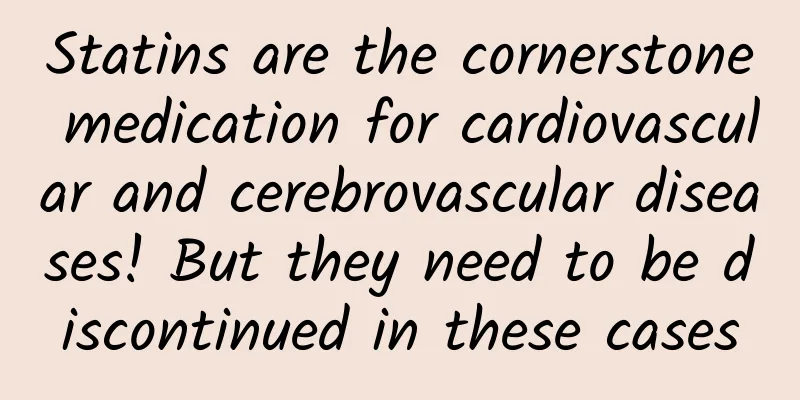Statins are the cornerstone medication for cardiovascular and cerebrovascular diseases! But they need to be discontinued in these cases

|
Cardiovascular and cerebrovascular diseases are already the number one disease threatening our lives and health. Severe myocardial infarction, heart failure, and cerebral infarction are all fatal. In order to control the development of cardiovascular and cerebrovascular diseases, patients with confirmed cardiovascular and cerebrovascular diseases, such as coronary heart disease, angina pectoris, myocardial infarction, heart stents, heart bypass surgery, severe carotid artery plaques, cerebral infarction, etc., need to take statins for a long time. However, like many drugs, statins have certain side effects. If treating a disease leads to another disease or organ damage, the cost will outweigh the benefits. If we take statins for a long time, under what circumstances do we need to stop taking statins? 1. What benefits can statins bring to cardiovascular and cerebrovascular diseases? Statins are not a single drug, but a large class of drugs, including simvastatin, lovastatin, pravastatin, fluvastatin, atorvastatin, pitavastatin, rosuvastatin, etc. The basic function of statins is to adjust blood lipids. They can reduce bad blood lipids such as total cholesterol, low-density lipoprotein, and triglycerides; especially reduce bad blood lipids such as low-density lipoprotein, thereby controlling vascular garbage and effectively controlling the progression of atherosclerosis. At the same time, statins can increase good blood lipids such as high-density lipoprotein, which can reduce vascular garbage and thus control atherosclerosis. In this way, statins can adjust blood lipids in a two-way manner, play a role in preventing and controlling the aggravation of atherosclerosis and controlling cardiovascular and cerebrovascular diseases. The second major effect of statins is anti-inflammatory and plaque stabilization. The formation and aggravation of atherosclerosis and the occurrence of plaques are caused, on the one hand, by the bad blood lipids we mentioned above, and on the other hand, by the inflammatory response of the vascular endothelium. The inflammatory response will aggravate and accelerate the process of atherosclerosis, thereby leading to vascular plaques, causing cardiovascular and cerebrovascular stenosis, and leading to cardiovascular and cerebrovascular diseases. Statins can fight inflammation, thereby controlling the progression of plaques. At the same time, statins can stabilize plaques, prevent plaques from rupturing and forming thrombi, prevent thrombi, and thus prevent myocardial infarction and cerebral infarction. 2. When should statins be discontinued? 1. When the transaminase level is 3 times higher One of the most common side effects of statins is that they affect liver function, but on the one hand it only occurs in a small number of people, and on the other hand most of them are transient. After close observation, as long as the transaminase does not exceed 3 times, you can continue to take it and observe closely. After the transaminase returns to normal, you can take it for a long time with relative peace of mind. Generally, elevated transaminases are most likely to occur in 1-6 months, so transaminases must be rechecked between the first month and half a year of taking the drug. Once elevated, especially if elevated by more than 3 times, the drug should be discontinued. Liver function should be rechecked once a year to check transaminases. After discontinuing the drug, ezetimibe or a PCSK9 inhibitor can be used instead. 2. When creatine kinase is 10 times higher Another common side effect of statins is muscle damage, fatigue, and muscle pain. A blood test for creatine kinase should be done. If the level is more than 10 times higher, the drug must be stopped immediately. For Chinese people, the risk of muscle damage is 10 times that of Europeans; the risk of myopathy is also increased in women, the elderly, people with low body mass index, and people with diabetes who are receiving hypoglycemic drugs. In order to reduce the risk of muscle injury, we should not take any medications without authorization, drink alcohol, stay up late less, observe for a long time, and seek medical attention in time if any problems are discovered. Myopathy is also likely to occur within 1-6 months of starting medication, so creatine kinase should be checked in the first month, sixth month, and every year thereafter. If creatine kinase exceeds 10 times, the medication must be stopped. 3. Other side effects The third most common side effect of statins is new-onset diabetes. However, the current view is that for patients who must take statins, even if they develop diabetes, it is not recommended to stop taking the medication immediately, because the benefits that statins can bring to these patients outweigh the harm caused by diabetes. Therefore, if diabetes occurs, it is not recommended to stop taking the medication, but to control blood sugar. Currently, it has occurred in Europeans, and pitavastatin has a relatively small effect on blood sugar. Of course, the instructions for a drug will list many side effects or adverse reactions. For example, statins may also cause nasopharyngitis, joint pain, diarrhea, limb pain, nausea, physical discomfort, nightmares, epistaxis, urticaria, blurred vision, tinnitus, positive white blood cells in urine, etc. However, the incidence of these adverse reactions is very low. If you are taking statins and experience the above symptoms and cannot be explained by other reasons, then you should suspect adverse drug reactions. If you cannot tolerate it, you must stop taking the drug. In short, statins have become the cornerstone medication for controlling cardiovascular and cerebrovascular diseases, and can even be said to be irreplaceable, but we must pay attention to the side effects of the drugs. We only need to grasp the indications, take the food when we should, and never take the food when we shouldn’t; at the same time, do regular check-ups while taking the food. Once the above-mentioned situations in which the medication must be discontinued occur, we should stop the medication as soon as possible! |
>>: What causes nausea during a headache? See what the doctor says
Recommend
Is pregnancy eczema fetal toxin?
The statement that pregnancy eczema is fetal toxi...
[Medical Q&A] What should you do if you are accidentally bitten by a snake?
Author: Zhou Feng Children's Hospital Affilia...
What to do if you feel dizzy and nauseous during your period
Women will experience various symptoms during the...
What does a gynecological blood test check?
Gynecological diseases require blood tests, mainl...
Menstruation is always unclean and brown
Menstruation is always unclean and accompanied by...
Diet after breast cancer chemotherapy, you need to know these points
Breast cancer is a common disease among women, an...
How do you feel after having an abortion?
Nowadays, people's awareness has become much ...
What is the cause of bad menstrual odor?
Women have menstruation every month, and this per...
What to do about antibody infertility
In fact, many women will have immune infertility,...
Disadvantages of eating spicy food for girls
Because the environment in Sichuan is relatively ...
Is the prawn the same as the big-headed prawn? How to remove the prawn thread from the prawn
The rosenbergii shrimp, also known as the white-f...
Care after hysterectomy
For women in their childbearing years, there are ...
Hallux valgus is ugly, should it be treated?
Author: Tang Qin, Deputy Secretary-General of the...
How long does it take to bleed after taking Jin Yuting?
Nowadays, living together before marriage is no l...
Why do I feel particularly sleepy during the third trimester of pregnancy?
Some normal pregnancy reactions for pregnant wome...









